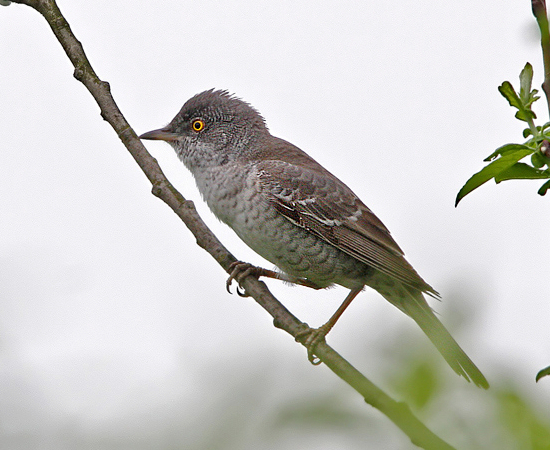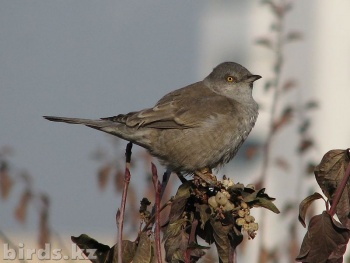- Curruca nisoria
Sylvia nisoria
Identification
15.5-17cm (6-6¾ in)
- Yellow iris
- White fringes to wing coverts and tertials forming a double wing bar
- White tail corners
Adult Male
- Steel grey upperparts
- Greyish-white underparts with dark barring
Adult Female
- Greyish-brown upperparts
- Less barred underparts
Immature
- Grey-brown upperparts
- Buffish underparts
- Undertail coverts have dark centers and pale fringes
- Brown eye
Similar species
First winter birds are similar to Garden Warbler but that species lack to pattern on undertail coverts
Distribution
The main breeding range is from eastern Germany, the Czech Republic and eastern Austria south-east to Bulgaria and east to the foothills of the Urals, the Caspian and Caucasus. Also breeds in scattered pockets in southern Sweden (mainly coastal areas and Öland and Gotland), and the south coast of Finland, in southern Switzerland and northern Italy, throughout the Balkans and possibly also Turkey. Formerly bred in southeastern Denmark, becoming extinct as a breeding species after 1998.
Leaves breeding areas in August-September to winter in East Africa, travelling via the eastern Mediterranean. Return movement takes place in mid-late May. Passage birds occur throughout east and Southeast Europe and the Middle East and occurs as a rare migrant as far west as Britain. Around 100-150, mainly 1st-winter birds, occur per year in Britain chiefly in the Northern Isles, on the east and south coasts and on Scilly. Most occur in August-October, very rare in spring.
Vagrant to Iceland, France, Belgium, Spain, Sardinia and Malta.
Taxonomy
This is a polytypic species[1] consisting of 2 subspecies.
Subspecies
- C. n. nisoria: Southern Scandinavia and Europe to the Ural Mountains; winters to eastern Africa
- C. n. merzbacheri: Western Siberia to northern Iran, Afghanistan and western China; winters to eastern Africa
Habitat
Open deciduous and mixed forest and woodland, plantations and shelterbelts, parks and large gardens. Also on bushy hillsides and in riverine scrub, hedgerows and in grassland with scattered trees and shrubs.
Behaviour
Diet
They eat mostly fruit and berries, except during the breeding season, when insects form a major part of their diet.
Breeding
They nest in mature scrubby thickets and hedgerows.
Vocalisation
Call: a dry rattle
Song: similar to Garden Warbler
References
- Clements, J. F., T. S. Schulenberg, M. J. Iliff, S. M. Billerman, T. A. Fredericks, J. A. Gerbracht, D. Lepage, B. L. Sullivan, and C. L. Wood. 2021. The eBird/Clements checklist of Birds of the World: v2021. Downloaded from https://www.birds.cornell.edu/clementschecklist/download/
- Collins Bird Guide ISBN 0 00 219728 6
- Birdwatchers Pocket Guide ISBN 1-85732-804-3
- Collins Field Guide 5th Edition
- Handbook of the Birds of the World Alive (retrieved March 2017)
- Høgesanger (Curruca nisoria) (status in Denmark)
Recommended Citation
- BirdForum Opus contributors. (2024) Barred Warbler. In: BirdForum, the forum for wild birds and birding. Retrieved 25 April 2024 from https://www.birdforum.net/opus/Barred_Warbler
External Links
GSearch checked for 2020 platform.1







